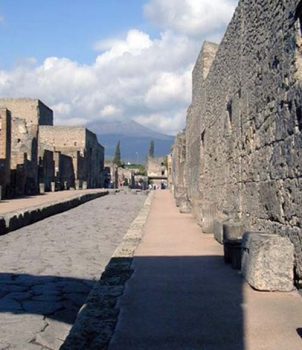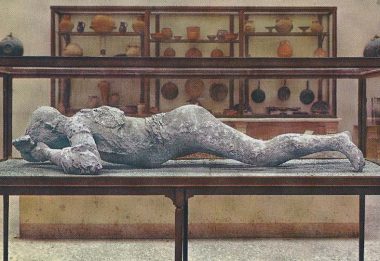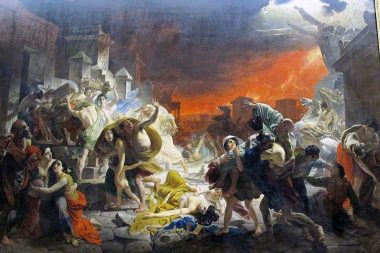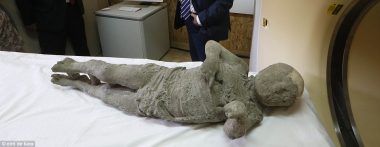The area of the ancient city Pompeii was firstly inhabited by the Neolithic population of the Campania who spoked Osci or Oscans language. The Oscan settlement of the Pompeii were located at the mouth of the Sarno (lat. Sarnus) River around 25 kilometers far from today’s Naples in Campania. In 8th century BC Oscan people came into contact with the Greeks and their culture but in 7th century BC Etruscans settled territory of Campania. Thus, the Etruscans were dominant in Campania and the influence of the Greek decreased. The first settlement on the site of Pompeii was built by Etruscans at the and of 7th century BC. The Etruscans were first build the city walls of Pompeii surrounding the approximately 63 hectares (around 155.676 acres) of territory. City Pompeii served to Etruscans as a safe harbor where they performed the trade.
After a battle of Cumae 524 BC in which the Greeks achieved victory against Etruscans, Umbrians and Daunians, the city of Pompeii was ruled by the Greek colony Cumae. In the 5th century BC, Samnite tribes came from the north to Apennine Peninsula (origin of the Samnites still not clear) and they conquered Campania including city Pompeii. The name Pompeii were first mentioned in the historical sources in 310 BC during the Second Samnite War (327/6-304 BC) when the Roman Fleet made an unsuccessful attack on nearby Nuceria. In the Third Samnite War, the Roman army at the Battle of Sentinum 295 BC achieved great victory over the Samnites.
In the final stage of the Samnite war, which ended five years later, Romans conquer the whole Campania and city Pompeii become a part of the Roman Alliance. The city has preserved its autonomy and started to develop rapidly, based on trading with wine and olive oil. By the beginning of the 2nd century BC all the important public buildings were built and decorated in city. The Pompeii Forum got a long colonnade (long sequence of columns) on three sides and became the center of religious, political and administrative life of the city. During the Roman Civil War and Roman struggle against Mithridates VI, the Pompeii moved to the side of other Italian cities who demanded Roman citizenship (civitates). General and Roman Consul Lucius Cornelius Sulla defeated the uprisings in Campania 89 BC, and city Pompeii were proclaimed as Colonia Cornelia Venerai Pompeianorum. This Roman colony was named after Sulla’s middle name Cornelius (gens or family) and after the Roman goddess Venus. The Pompeii lost their status as a free city, and the city was forced to accept Roman law. Soldiers from Sulla’s army as a gift for achieved victory got the portion of land around the city of Pompeii. Oscan language in Pompeii was replaced by Latin language. The city were soon spread by Roman institutions, architecture and culture. Famous families in the city of Pompeii (Popidius, Trebius and Holconius) have lost their power in favor of new population. Samnite temples were Romanized, the Jupiter’s temple was converted into the Capitol, thermal baths, amphitheater and other public objects were built in the city.



The city of Pompeii also developed rapidly during the emperor Octavian Augustus and emperor Vespasian. At the time of the greatest rise, Pompeii could have between 11,000 and 20,000 inhabitants. The central city square, the Forum, was surrounded by political, religious and business institutions from all sides. There was also the main town market with two exchange offices, the headquarters of wool production, temple of Vespasian, the seat of city councilors, the offices of judges, the basilica and the temples of the God of Apollo and the goddess Venus, the patron of the city. Nearby was the oldest temple in Pompeii, the big theater and the practice center. In the eastern part of the city was dominated by an amphitheater, and by the west a large exercise ground replaced by an old Samnite training ground. In addition to public baths scattered throughout the city, the wealthy inhabitants of Pompeii had private bathing resorts in their luxurious homes. There was also a large brothel, known as Lupanar (from Latin word lupa or prostitute) of Pompeii. It was the best organized brothel in Pompeii, with numerous rooms, lounges and stone beds covered with mattresses. The walls of the Lupanar were painted with depictions of different erotic poses. The prostitutes were slaves, mostly from Greece or from the Orient.
Great damage to the city of Pompeii and neighboring towns of Herculaneum and Stabiae caused by earthquake on 5th February 62 AD. However, due to the strong economy, the city of Pompeii has been partially restored.
Cataclysm of Pompeii, Volcanic eruption 79 AD
The Pompeii, Herculaneum and Stabiae were built several kilometers from Mount Vesuvius. Since the volcano Vesuvius did not show great signs of activity, the inhabitants of these cities were not aware of the dangers. And then the fatal 24th August 79 AD came when dissolved rock turned into a foam that, together with the gas, created a column that climbed up to 15 kilometers in height. The wind carried this cloud directly to Pompeii and darkened the whole city in the middle of day. Incandescent rock pieces mixed with the air, started to fall towards the ground. Ash and other volcanic remains soon covered the city with a thickness of about 3 meters. The volcano broke out around 1.5 million tons of lava per second, and the temperature of the sprayed lava was up to 1000°C. The scared inhabitants of Pompeii did not know what had happened. Many residents have tried to run away and carry the wealth they have acquired so far. The slaves had to keep their masters and their property. Some of them escaped knowing that if they caught them, they would be sentenced to death. Some residents took refuge in the basement of their house and praying while some of them have chosen fast death in poisoning.



There are plenty of different theories about the causes of the deaths of unlucky residents of the Pompeii, Herculaneum and Stabiae. According to one theory most of the population died of choking by toxic gases from lava and from the storm of volcanic rocks. Some says that the streams of lava ignited and so killed the inhabitants and other says that more than 13% of the population of Pompeii died at the time of the initial explosion of Volcano. A detailed description of the eruption was known thanks to Pliny the Younger (61-113 AD) the lawyer, famous writer and magistrate of Ancient Rome who was himself a witness to cataclysm. The two letters (Epistulae) written on the death of his uncle Pliny the Older on the request of Cornelius Tacitus brought precise observations of the consequences caused by eruption. Information from those letters were confirmed by archaeologist research. At the time of the volcano eruption, Pliny the Younger lived with his mother and uncle Pliny the Elder in the city Misenum (around 60 kilometers far from Pompeii). His uncle, Pliny the Elder (23-79 AD), a prominent scientist, was the commander of a Roman fleet that was at that time stationed in a quiet bay of Misenum. Pliny the Elder had the desire to observe a volcano from close distance. He sailed directly to the site of the eruption and there he died. In the second letter sent by Plinius the Younger to Tacitus, he describes experiences in Misenum at the time of eruption:
“You say that the letter which I wrote to you at your request, describing the death of my uncle, has made you anxious to know not only the terrors, but also the distress I suffered while I remained behind at Misenum…After my uncle had set out I employed the remainder of the time with my studies, for I had stayed for that very purpose. Afterwards I had a bath, dined, and then took a brief and restless sleep.
Form many days previous there had been slight shocks of earthquake, which were not particularly alarming, because they are common enough in Campania. But that night the shocks were so intense that everything round us seemed not only to be disturbed but to be tottering to its fall. My mother rushed into my bedchamber, just as I myself was getting up in order to arouse her if she was still sleeping….
It was now the first hour of the day, but the light was still faint and weak. The building all round us were beginning so totter, and, though we were in the open, the courtyard was so narrow that we were in the open, and indeed sure of being overwhelmed by their fall. So that decided us to leave the town. We were followed by a distracted crowd, which, when in a panic…We came to a halt when we had passed beyond buildings, and underwent there many wonderful experiences and terrors. For although the ground was perfectly level, the vehicles which we had ordered to be brought with us began to sway to and fro, and though they were wedged with stones, we could not keep them still in their places. Moreover, we saw the sea drawn back upon itself, and as it were, repelled by the quaking of the earth. The shore certainly was greatly widened, and many marine creatures were stranded on the dry sands. On the other side, the black, fearsome cloud of fiery vapour burst into long, twisting, zigzag flames and gaped asunder, the flames resembling lightning flashed, only they were of greater size…
Soon afterwards the cloud descended upon the earth, and covered the whole bay; it encircled Capreae and hid it from sight, and we could no longer see the promontory of Misenum…Then the ashes began to fall, but not thickly: I looked back, and a dense blackness was rolling up behind us, which spread itself over the ground and followed like a torrent…We were considering what to do, when the blackness of night overtook us, not what of a moonless or cloudy night, but the blackness of pent-up places which never see the light.You could hear the wailing of woman, the screams of little children, and the shouts of men; some were trying to find their parents, others their children, other their wives…A gleam of light now appeared, which seemed to us not so much daylight as a token of the approaching fire.
The latter remained at a distance, but the darkness came on again, and the ashes once more fell thickly and heavily. We had to keep rising and shaking the latter off us, or we should have been buried by them and crushed by their weight…At length the blackness became less dense, and dissipated as it were into smoke and cloud; then came the real light of day, and the sun shone out..Making our way back to Misenum, we refreshed our bodies as best we could…”
A few days later, the Emperor’s Senate Commission from Rome came to the tragedy spot of Pompeii to organize survival assistance. The survivors had only the option to find the remains of their family and their sacred objects, and to settled somewhere else. After helping the survivors, the city was completely abandoned and forgotten.
Archaeological excavations of Pompeii



Italian architect Domenico Fontana (1543 – 28 June 1607) who worked 1592 on changing Sarno river flow accidentally discovered walls of Pompeii covered with paintings and inscriptions but this did not attract the public. At that time, the public still did not know the meanings of the ruins. During the digging of a well in 1709, the remains of the town Herculaneum were discovered. The first systematic excavation of the Herculaneum had begun 1738 and the excavation of Pompeii begun ten years later 1748. Studies of these cities started under the patronage of King Charles III of Naples Bourbon. With this research, the development of archeology as a modern science has also begun. In the period from 1750 to 1764, military engineer Karl Weber systematically studied the remains of Pompeii. A sign of city in 1763 were discovered and thus it was confirmed the real name of the Pompeii. During the excavation of Herculaneum and Pompeii, the researchers had found an artwork with erotic scenes. Occasionally closed to the public because of the neglect of moralists, these works are now housed in “Secret Room” at todays National Archaeological Museum in Naples.



However, from 1764-1863 excavations has been conducted improperly and researchers were often in fact treasure hunters. But in 1863 Italian archaeologist Giuseppe Fiorelli became the head of the archaeological research of Pompeii. Areas of the site were precisely and carefully marked. His research has contributed to a better understanding of the history of the city. Important discoveries and studies on the city of Pompeii are the work of Amedeo Maiuri in the period 1924 to 1961. Especially the emotional are scenes in which the whole bodies of victims laying in original pose plastered during the eruption. Scientists today, throughout modern technology, also investigating the causes of the deaths including anatomy of victims in Pompeii.
References:
- The Letters oh the Younger Pliny, translated by John B. Firth, London, New York 1900.
- Kraus Theodor, Pompeii and Herculaneum: The Living Cities of the Dead, 1975.
- Beard Mary, Pompeii: The Life of a Roman Town, London 2008.
- Butterworth Alex; Laurence Ray, Pompeii: The Living City, New York 2005.
- Zarmati Louise, Heinemann ancient and medieval history: Pompeii and Herculaneum, 2005.
- Salvatore Ciro Nappo, Pompeji – Die versunkene Stadt, Archäologischer Reiseführer, Köln 2004.
